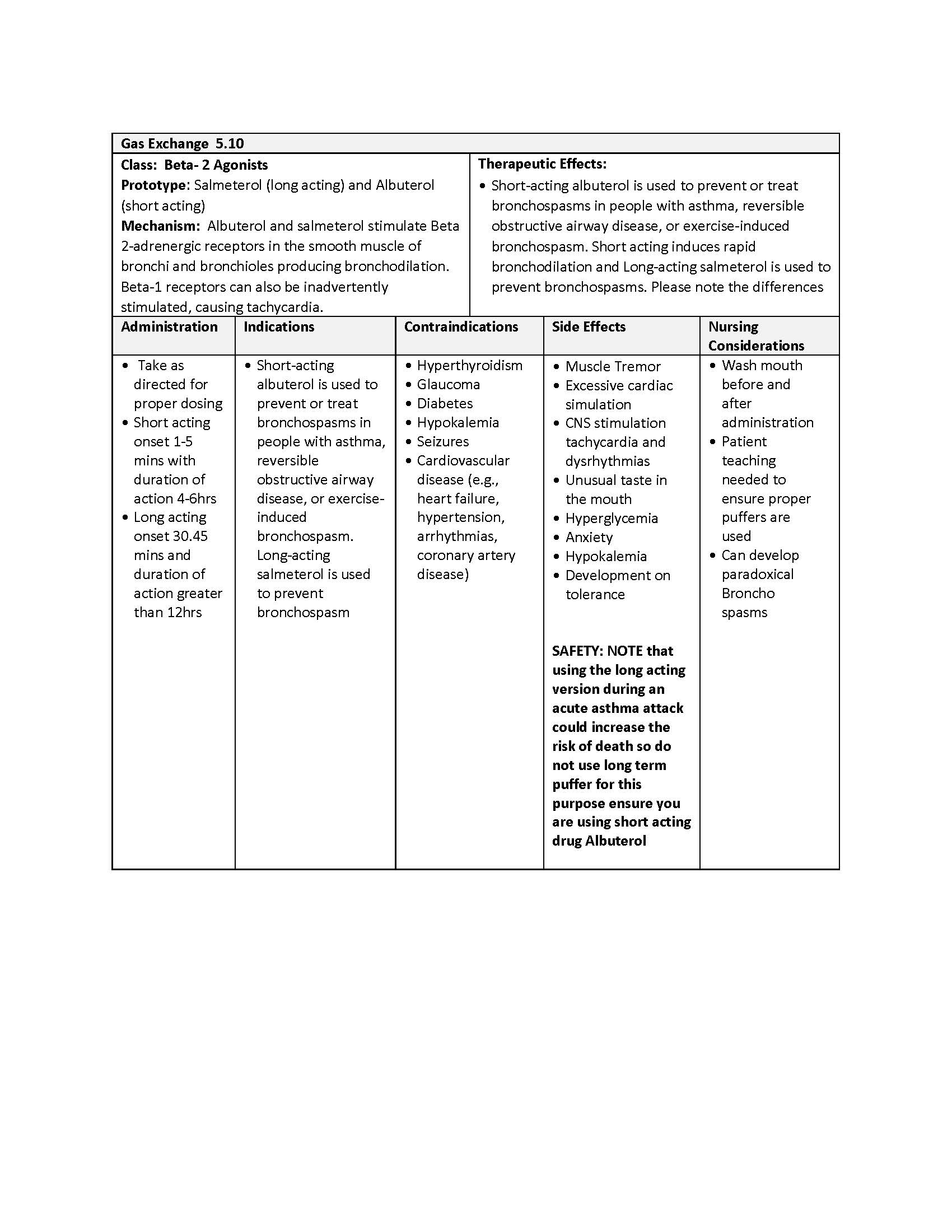Gas Exchange
5.10 Beta-2 Agonist
Open Resources for Nursing (Open RN)
Beta-2 Agonist
Albuterol is an example of a short-acting Beta-2 agonist. See Figures 5.10[1] and 5.10a[2] for images of an albuterol inhaler and nebulizer.
Salmeterol is an example of a long-acting Beta-2 agonist.
See the “Autonomic Nervous System” chapter for more information regarding Beta-2 agonists.


Mechanism of Action
Albuterol and salmeterol stimulate Beta 2-adrenergic receptors in the smooth muscle of bronchi and bronchioles producing bronchodilation. Beta-1 receptors can also be inadvertently stimulated, causing tachycardia.
Indications for Use
Short-acting albuterol is used to prevent or treat bronchospasms in people with asthma, reversible obstructive airway disease, or exercise-induced bronchospasm. Long-acting salmeterol is used to prevent bronchospasm.
Adverse/Side Effects
Beta-2 agonists can cause muscle tremor, excessive cardiac stimulation, and CNS stimulation.[3]
Beta 2- Agonists Across a Life Span
Beta 2 receptors are found in babies from the 16th week of gestation. Short acting Beta 2-agonists therefore work well for children with asthma attacks as needed with chronic asthma. Some examples of usage include salbutamol or albuterol, and terbutaline. The best route to choose for preschool-aged children is a pressurized metered dose inhaler with a spacer device. Since there are some new oral formulations that are long acting Beta 2-agonists, medical investigation is underway as to whether the use of these oral forms for the child age population would be appropriate. Currently though, short acting Beta 2-agonists are used.
Client Teaching & Education
Clients should be instructed to take medication as directed and report to their healthcare provider any sustained or worsening symptoms. When first using an inhaler, clients should be instructed to prime the inhaler unit prior to administering their medication. Use of medications like albuterol can cause an unusual taste in the mouth, and rinsing the mouth with water after use is permitted. Clients should have an understanding of medication onset and use short-acting and long-acting inhalers appropriately.[4]
Now let’s take a closer look at the medication card for albuterol and salmeterol in Table 5.10.[5],[6],[7],[8],[9]
Table 5.10 Albuterol and Salmeterol Medication Card

Media Attributions
- image12-5
- image2-7
- Beta 2 Agonist
- "Ventolin® HFA (Albuterol Sulfate) Inhaler.jpg" by MisterNarwhal is licensed under CC BY SA 4.0 ↵
- "Albuterol 2.jpg" by Mark Oniffrey is licensed under CC BY SA 4.0 ↵
- Frandsen, G. & Pennington, S. (2018). Abrams’ clinical drug: Rationales for nursing practice (11th ed.). Wolters Kluwer. ↵
- uCentral from Unbound Medicine. https://www.unboundmedicine.com/ucentral ↵
- This work is a derivative of Pharmacology Notes: Nursing Implications for Clinical Practice by Gloria Velarde licensed under CC BY-NC-SA 4.0. ↵
- This work is a derivative of Daily Med by U.S. National Library of Medicine in the public domain. ↵
- Frandsen, G. & Pennington, S. (2018). Abrams’ clinical drug: Rationales for nursing practice (11th ed.). Wolters Kluwer. ↵
- This work is a derivative of Daily Med by U.S. National Library of Medicine in the public domain. ↵
- Adams, M., Holland, N., & Urban, C. (2020). Pharmacology for nurses: A pathophysiologic approach (6th ed.). pp. 622-63 & 626. Pearson. ↵

